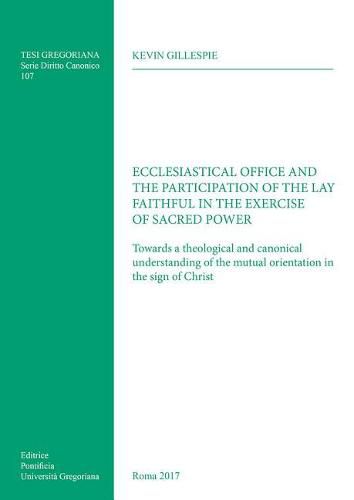Readings Newsletter
Become a Readings Member to make your shopping experience even easier.
Sign in or sign up for free!
You’re not far away from qualifying for FREE standard shipping within Australia
You’ve qualified for FREE standard shipping within Australia
The cart is loading…






The parameters for the relationship between the ordained and the non-ordained in the Church’s mission, particularly in the realm of public functioning and the power of jurisdiction, are set frequently by reference to a limiting interpretation of the formula of Lumen Gentium 10b, regarding the relationship of the common and ministerial priesthood. This study illustrates how the same formula emphasises the dynamic of mutual orientation that determines this relationship. This dynamic is illustrated by an exploration of theme of the common priesthood in scripture, theology and the magisterium. Two other themes are significant for a proper understanding of the mutual orientation in question: the origin and nature of the power of governance, and the personal or institutional nature of the power exercised in ecclesiastical office. Given the importance of ecclesiastical office as a juridical institution for the Church’s public functioning, the theological-juridical category munus emerges as both unifying and orienting for the relationship between the ordained and non-ordained in the exercise of office. The study sustains that ecclesiastical offices have a primordial content based on the nature of one’s sacramental participation in the priesthood of Christ, and the consequent participation in his threefold munera. This is significant for appointment to ecclesiastical office, its proper exercise, and the authoritative nature of public functioning.
$9.00 standard shipping within Australia
FREE standard shipping within Australia for orders over $100.00
Express & International shipping calculated at checkout
The parameters for the relationship between the ordained and the non-ordained in the Church’s mission, particularly in the realm of public functioning and the power of jurisdiction, are set frequently by reference to a limiting interpretation of the formula of Lumen Gentium 10b, regarding the relationship of the common and ministerial priesthood. This study illustrates how the same formula emphasises the dynamic of mutual orientation that determines this relationship. This dynamic is illustrated by an exploration of theme of the common priesthood in scripture, theology and the magisterium. Two other themes are significant for a proper understanding of the mutual orientation in question: the origin and nature of the power of governance, and the personal or institutional nature of the power exercised in ecclesiastical office. Given the importance of ecclesiastical office as a juridical institution for the Church’s public functioning, the theological-juridical category munus emerges as both unifying and orienting for the relationship between the ordained and non-ordained in the exercise of office. The study sustains that ecclesiastical offices have a primordial content based on the nature of one’s sacramental participation in the priesthood of Christ, and the consequent participation in his threefold munera. This is significant for appointment to ecclesiastical office, its proper exercise, and the authoritative nature of public functioning.